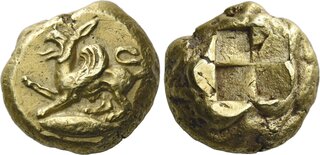| Numismatica Ars Classica > Auction 146 | Auction date: 8 May 2024 |
| Lot number: 2206 Price realized: This lot is for sale in an upcoming auction - Bid on this lot  | Show similar lots on CoinArchives Find similar lots in upcoming auctions on |
| Lot description: Mysia, Cyzicus. Stater circa 500-450, EL 19 mm, 16.03 g. Griffin crouching l., right forepaw raised; below, tunny. Rev. Quadripartite incuse square. von Fritze 99. Boston, MFA 1455. SNG France 240. Very rare and in exceptional condition for the issue. Perfectly struck in high relief on a full flan and extremely fine Ex NAC 11, 1998, 69 and NAC 77, 2014, 54 sales. The Cyzicenes portrayed griffins on their electrum coins on more than one occasion, which is hardly surprising in light of their brisk trade with the people residing on northern shores of the Black Sea, by which they gained access to the gold mined still further north, in a land many Greeks called Hyperborea. Though it was universally acknowledged as being well north of the Greek world, the precise location of Hyperborea was reported differently in the ancient sources. Suggestions ranged from Britain to an area north of the Alps, to somewhere in the Urals, and even, perhaps, the Arctic circle. Ptolemy believed that it was in the vicinity of the North Sea, which he called the Hyperborean Ocean. Scores of ancient authors refer to the land of Hyperborea or its inhabitants, including Apollonius of Rhodes, Hesiod, Homer, Pindar, Sophocles, Strabo, and Herodotus, who reports (iii.116): "Then again towards the North of Europe, there is evidently a quantity of gold by far larger than in any other land: as to how it is got, here again I am not able to say for certain, but it is said to be carried off from the griffins by Arimaspians, a one-eyed race of men. But I do not believe this tale either, that nature produces one-eyed men which in all other respects are like other men. However, it would seem that the extremities which bound the rest of the world on every side and enclose it in the midst, possess the things which by us are thought to be the most beautiful and the most rare." Hyperborea was commonly said to have been protected by the fearsome, mythological griffins. The god Apollo was closely associated with these creatures due to the famous legend of his visit to the land of the Hyperboreans. Indeed, his chariot is sometimes represented as being pulled by a griffin, or the god himself is sometimes shown riding on the back of a griffin. Thus, Greenwell suggests that the Cyzicenes associated Apollo with the griffin-guarded gold of Hyperborea – the very gold that was crucial to the prosperity of this city, and the production of its coinage. Estimate: 15000 CHF |  |



